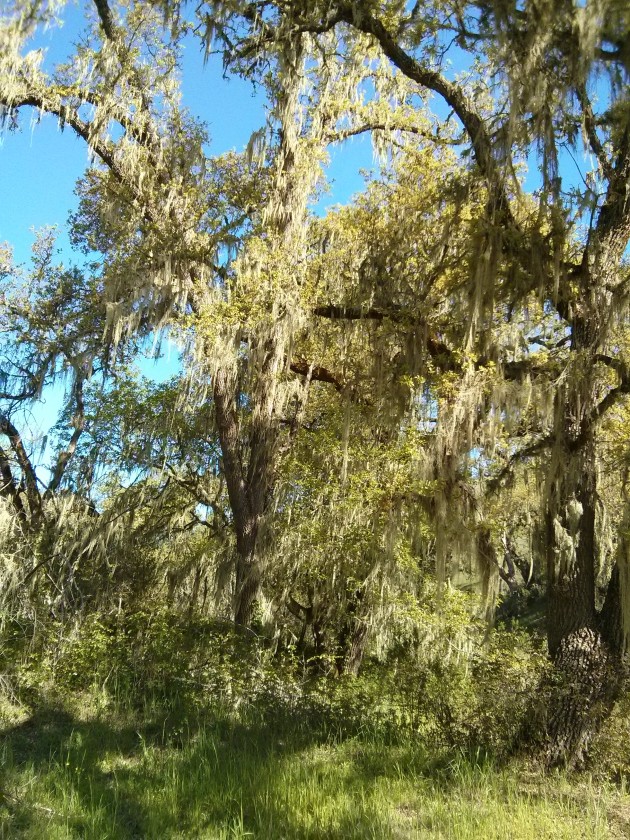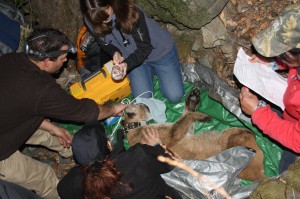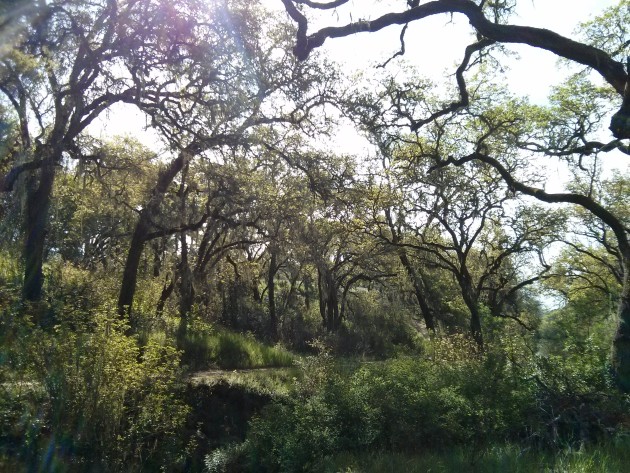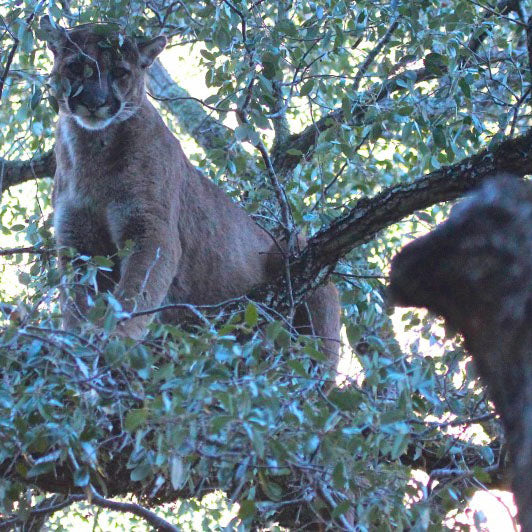(Repost): Original Post: https://baynature.org/article/tracking-ghosts/
From under the shade of an oak tree, deep in the forests of the Blue Oak Ranch Reserve in San Jose, the slope descends steeply in a dense tangle of slippery grass and branches. Nine hundred feet below, where the Arroyo Hondo River cuts through the canyon, the East Bay’s first GPS-collared mountain lion has resided for 10 days. The signal shows that she has moved on, but the biologists are curious. Ten days is a long time for a mountain lion without kittens to stay in place. It’s likely she made a kill — a large one.
Leaves rustle and the afternoon sun streams through the trees. There is really only one way to find out what the lion has left behind. Clutching the side of the tree, sweating and panting in the already warm spring heat, I look at my two intrepid guides, biologists with the East Bay Puma Project. They look at their GPS, and then at me. We all look down the hill.

David Tharp has been “chasing cats” for the Bay Area Puma Project (BAPP), a research, education, and conservation program for pumas in the Bay Area, for the last five years. Mountain lion and bobcat tattoos prowl across his arms and legs. Together with Ally Nauer, my other guide, and the Puma Project team, he has been helping collar mountain lions and monitor remote motion-sensor cameras throughout the East Bay. It’s not easy tracking the elusive cats, but it’s vital to understanding how to protect them.
“There’s been lots of research on African lions, but what about our North American lions?” says Zara McDonald, president of the Felidae Conservation Fund, which runs the Puma Project. “It’s astonishing that we don’t know more about them.”
Even basic questions need answers. How many mountain lions are there in the Bay Area? What are they eating? How far do they roam? Certainly, living so close to an urban environment affects them — but how much?
When mountain lions step out of their shadow world and into ours, they make headline news. Like in early July, when a San Mateo man encountered a 100-pound lion in the wooded area behind his home. Or in early May, when a young male lion wandered into Mountain View and got trapped in a parking garage before being tranquilized and returned to the wild. Young male lions are frequently seen while trying to disperse, when their wanderings sometimes take them into a confusing and dangerous maze of homes, dogs, people, and highways that bisect their habitat. But most reported mountain lions sightings are misidentified, McDonald says: “85-90 percent of them are actually bobcats, deer, or even large house cats,” she says.
Mountain lions are rare for humans to see in the wild, and difficult to study. Even our names for mountain lions elude definition. As a species that ranges from the Canadian Yukon to the tip of South America, from sea level to 2,000 feet, Puma concolor has acquired a variety of descriptive monikers: puma, panther, catamount (cat of the mountain), and painter in the Southern United States. The common name puma comes from Quechua, the language of the Incas, who some believe built their capital city, Cuzco, in the shape of the golden cat. The name “cougar” has similarly exotic origins, likely borrowed from the Portuguese çuçuarana; a term originally derived from the Tupi language susua’rana, meaning “similar to deer,” in reference to the cat’s golden-brown fur. But as we hike through the oak woodlands in search of the cats, or simply some sign of their presence on the landscape, there is one name that seems the most fitting: ghost cat. Indeed, they seem more like a legend than reality — mysterious, enigmatic, secretive – like wisps of smoke in the forest.

The California Department of Fish and Wildlife estimates the total number of mountain lions in California at 4,000-6,000 individuals. But that estimate is now 30 years old, and, according to Tim Dunbar of the Mountain Lion Foundation, based on a simplistic model. “Basically,” Dunbar says, “they extrapolated based on how much habitat there was for deer herds and how much space lions need.”
But there are a variety of other factors, including type of habitat, availability of non-deer prey, competition from other lions, and accessibility to mates that determines how many lions a given area of land can support. Dunbar’s group has estimated 3,000-4,000 lions in California and decreasing, mainly, he says, because of habitat loss. Development is increasingly chopping up habitat in the East Bay, and in Southern California, Dunbar says, some lions exist on isolated islands of habitat totally cut off from mates.
The goal of the Bay Area Puma Project is to increase knowledge and understanding about Bay Area mountain lion populations with the hope of facilitating a more peaceful coexistence between the secretive felines and humans. Since 2008, project biologists have collared roughly 45 individuals and estimated a population of 50-70 lions in the Santa Cruz Mountains. Mountain lions, they’ve found, are adaptable and can vary their needs depending on habitat quality.
“Some can have home ranges as big as 400 square miles in places where food is scarce, like the desert,” McDonald says. But in richer habitats like the Santa Cruz Mountains, with more cover, prey, water, and access to mates, the lions are more condensed, with average territory sizes ranging from 35 square miles for a female and 100 square miles for a male.
High-tech accelerometers embedded in the collars used by the Puma Project in the Santa Cruz Mountains have allowed researchers to look at not just the location of a mountain lion, but also infer its behavior in a given area. The information is helping to better define how proximity to humans affects habitat quality. After tracking 20 lions over 6,000 square miles for three years, Puma Project biologists observed that while lions are willing to brave rural neighborhoods, when it comes to reproductive behavior and denning, they need more seclusion. Lions came closer to urban areas while moving or feeding, but in general give a wider berth to areas with people.
Remote motion-sensor cameras in the East Bay tell a similar story over the last four years. Although the Puma Project is just starting to collar lions here, the images have shown less mountain lion presence in the highly urbanized areas of the Berkeley and Oakland hills than further south in more remote pockets of East Bay habitat.

Blue Oak Ranch Reserve, a rugged assemblage of chaparral, blue and coast live oaks, and bay-laurel woodlands in the foothills of the Mount Diablo Range, is one of those more remote pockets. F1, a 3-4 year old, 90-pound female lion, was first collared here in December 2013, and since then has been bouncing over 40-60 square miles from Alum Rock Park and beyond into the wilds of the Blue Oak Ranch Reserve, especially its deep canyons. As the first lion collared in the East Bay, and as a female of kitten-bearing age, her movement and behavior are monitored closely. She’s a “prime cat,” McDonald says.

The Puma Project hopes to collar as many lions as possible in the East Bay over the next couple of years. They currently have their sights on a large male – and potential suitor for F1 – who had been showing up on camera traps during last year’s fawning season.
Although the cameras have been baited in various ways — some with scent, some with road-killed deer — they haven’t been capturing any evidence of the cats recently. “We are feeding everything but the lions,” says Tharp, as we make the morning drive toward the slowly brightening green hills of Alum Rock Park, on our way to check the first of several cameras for mountain lion activity.
In the misty morning air under an oak grove Ally Nauer looks through the photos taken by the first camera over the past couple days. “Just us and a turkey,” she says with a slight laugh.
Checking the remaining cameras takes us on a drive through the ruddy outcroppings of Alum Rock Park, through the moss-draped oaks of the Sierra Vista Open Space Preserve, and onwards into the Blue Oak Ranch Reserve with oaks twisting through the blue sky like crackled frames. We hike to various spots beneath trees and beside creeks, and with each camera, Nauer repeats a similar story: “Turkey, fox … that’s you from yesterday.” “Bobcat, us … skunk.”
Some cameras only get checked once every couple of months, but baited cameras have to be checked more often to make sure the deer hasn’t gone bad. Thorpe worries that such frequent visits could actually be scaring the lions away, so he and Nauer decide to cut down the deer and try scent baiting instead. There are some options: Calvin Klein Obsession for Men is apparently a popular – and classy – choice for attracting both mountain lions and bobcats, but so is “Wildcat Lure No.1” with a smell somewhere between dead skunk and dead deer on a hot day.

We’ve checked cameras for several hours before we arrive at the hillside looking down on F1’s potential kill site. The sun is already beginning its curving arc toward evening. The steep descent – and return climb it would mean — intimidates, as does the prospect of hours spent to find out where the lion has stashed the remains. Mountain lions like to hide their kills, not unlike the way a housecat stashes its toy mice under the couch.
So the biologists shake their heads, and with a slight sigh decide to leave F1’s kill alone, for now. As we march back to the truck and away from the canyon, Tharp and Nauer resign themselves to the possibility of coming back another day, with an earlier start, and much more food and water.
Chasing ghosts can be tiring, and disappointing. And yet – the GPS point stands as digital proof that not too long ago F1 was close by. Not mist, not smoke, but a real lion eating its kill in the shade of cottonwood trees.

In his 1991 book Incident at Eagle Ranch, Donald Scueler writes, “The mountain lion works a strong magic in the imagination of many Americans. It is the ultimate loner, a renegade presence in the wildest canyons and wildest mountains, the sign of everything that is remote from us, everything we have not spoiled.”
Tharp admittedly craves that contact. His line of work has brought him into contact with six lions, not counting the time he helped collar F1. No one knows better how shy they are, and the lengths they go to, to avoid human contact. “Every one you see is ass and tail and feet,” he says. “The reason you see them is they just made a mistake.”
And sometimes they don’t even seem to inhabit the same dimension as humans, like the time Tharp was out checking a Sierra Vista camera and a lion walked right by him and didn’t notice. “I was almost to the final creek crossing when I saw movement, and then an adult puma coming right at me,” he says. With no time to react, Tharp stood motionless in disbelief as the lion trotted right past him, its eyes fixed on a point far in the distance. “It was like he didn’t even see me,” he says.
Though their lives are often shrouded in mystery, and there is still a lot to learn about mountain lions in the Bay Area, we already know some of the ways they enrich the landscape simply by living here: they bring the ecosystem into balance, keep deer populations robust by preying on weak and diseased individuals, and leave kill remains that provide food for a myriad of other species. But there is also a certain intangible satisfaction in knowing they are here.
“It’s about the concept of what enriches us as human beings — that we have the last apex predators,” McDonald says. “We are very fortunate to still have lions here. To know that they are out there.”
A few hours after coming down from the mountain, a few hours after coming tantalizingly close to the world of the mountain lion, I sit in traffic on Highway 101 amidst the droning of cars, the zigzagging of overpasses and yellow lines. Thoughts of quiet forests, silent paws and the ghost cats fill my head. I think I understand what McDonald means.
